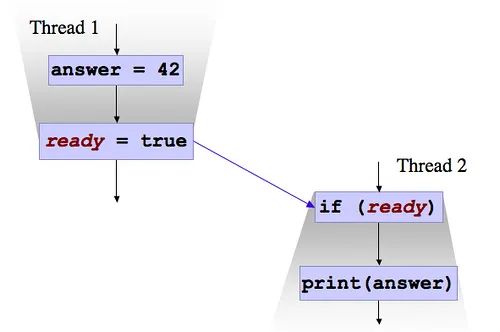从volatile说到i++的线程安全问题
阅读本文大概需要 4 分钟。
简介
Thread的本地内存
每个Thread都拥有自己的线程存储空间
Thread何时同步本地存储空间的数据到主存是不确定的
例子

借用Google JEREMY MANSON 的解释,上图表示两个线程并发执行,而且代码顺序上为Thread1->Thread2。
1. 不用 volatile
假如ready字段不使用volatile,那么Thread 1对ready做出的修改对于Thread2来说未必是可见的,是否可见是不确定的.假如此时thread1 ready泄露了(leak through)了,那么Thread 2可以看见ready为true,但是有可能answer的改变并没有泄露,则thread2有可能会输出 0 (answer=42对thread2并不可见)。
每次修改volatile变量都会同步到主存中
每次读取volatile变量的值都强制从主存读取最新的值(强制JVM不可优化volatile变量,如JVM优化后变量读取会使用cpu缓存而不从主存中读取)
线程 A 中写入 volatile 变量之前可见的变量, 在线程 B 中读取该 volatile 变量以后, 线程 B 对其他在 A 中的可见变量也可见. 换句话说, 写 volatile 类似于退出同步块, 而读取 volatile 类似于进入同步块
注意
public class VolatileTest {private static volatile int count = 0;private static final int times = Integer.MAX_VALUE;public static void main(String[] args) {long curTime = System.nanoTime();Thread decThread = new DecThread();decThread.start();// 使用run()来运行结果为0,原因是单线程执行不会有线程安全问题// new DecThread().run();System.out.println("Start thread: " + Thread.currentThread() + " i++");for (int i = 0; i < times; i++) {count++;}System.out.println("End thread: " + Thread.currentThread() + " i--");// 等待decThread结束while (decThread.isAlive());long duration = System.nanoTime() - curTime;System.out.println("Result: " + count);System.out.format("Duration: %.2fs\n", duration / 1.0e9);}private static class DecThread extends Thread {@Overridepublic void run() {System.out.println("Start thread: " + Thread.currentThread() + " i--");for (int i = 0; i < times; i++) {count--;}System.out.println("End thread: " + Thread.currentThread() + " i--");}}}
Start thread: Thread[main,5,main] i++
Start thread: Thread[Thread-0,5,main] i--
End thread: Thread[main,5,main] i--
End thread: Thread[Thread-0,5,main] i--
Result: -460370604
Duration: 67.37s
void f1() { i++; }
void f1();Code:0: aload_01: dup2: getfield #2; //Field i:I5: iconst_16: iadd7: putfield #2; //Field i:I10: return
Thread1 Thread2r1 = i; r3 = i;r2 = r1 + 1; r4 = r3 + 1;i = r2; i = r4;
线程同步问题的解决
package com.qunar.atomicinteger;import java.util.concurrent.atomic.AtomicInteger;/*** @author zhenwei.liu created on 2013 13-9-2 下午10:18* @version $Id$*/public class SafeTest {private static AtomicInteger count = new AtomicInteger(0);private static final int times = Integer.MAX_VALUE;public static void main(String[] args) {long curTime = System.nanoTime();Thread decThread = new DecThread();decThread.start();// 使用run()来运行结果为0,原因是单线程执行不会有线程安全问题// new DecThread().run();System.out.println("Start thread: " + Thread.currentThread() + " i++");for (int i = 0; i < times; i++) {count.incrementAndGet();}// 等待decThread结束while (decThread.isAlive());long duration = System.nanoTime() - curTime;System.out.println("Result: " + count);System.out.format("Duration: %.2f\n", duration / 1.0e9);}private static class DecThread extends Thread {public void run() {System.out.println("Start thread: " + Thread.currentThread() + " i--");for (int i = 0; i < times; i++) {count.decrementAndGet();}System.out.println("End thread: " + Thread.currentThread() + " i--");}}}
Start thread: Thread[main,5,main] i++
Start thread: Thread[Thread-0,5,main] i--
End thread: Thread[Thread-0,5,main] i--
Result: 0
Duration: 105.15
结论
volatile解决了线程间共享变量的可见性问题
使用volatile会增加性能开销
volatile并不能解决线程同步问题
解决i++或者++i这样的线程同步问题需要使用synchronized或者AtomicXX系列的包装类,同时也会增加性能开销
推荐阅读:
微信扫描二维码,关注我的公众号
朕已阅 
评论

